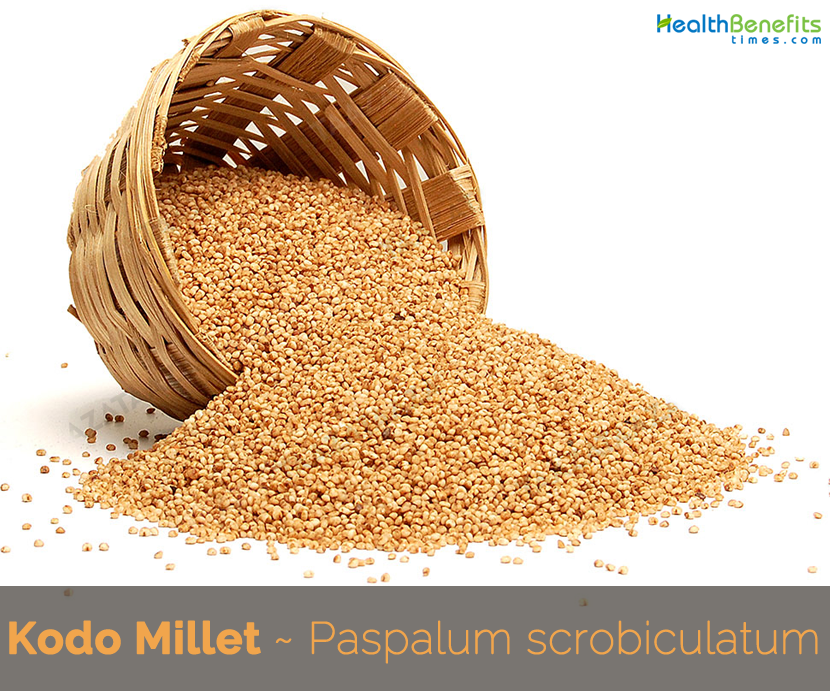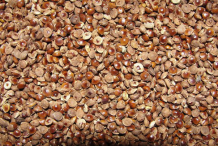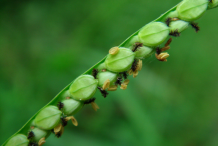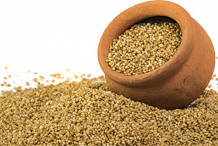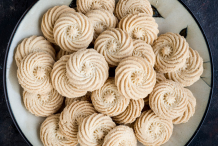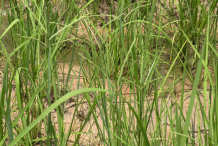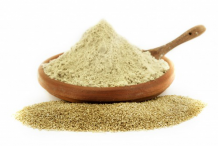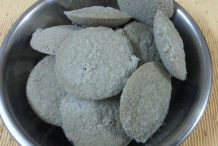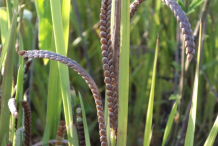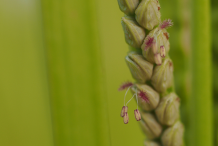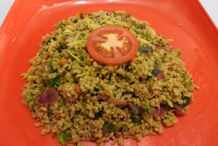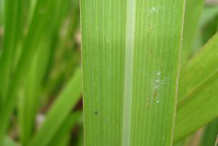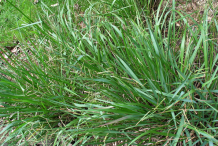| Kodo millet Quick Facts |
| Name: |
Kodo millet |
| Scientific Name: |
Paspalum scrobiculatum |
| Origin |
Sub-Saharan Africa from Senegal east to Ethiopia and south to South Africa |
| Colors |
Vary in color from being light brown to a dark grey (Seed) |
| Shapes |
Very small and ellipsoidal, being approximately 1.5 mm in width and 2 mm in length (Seed) |
| Taste |
Sweet, bitter, Astringent |
| Health benefits |
Anti-diabetic, Anti-obesity, Anti-cholesterol and anti-hypertension, Helps in weight management, Cholesterol reduction |
Kodo millet scientifically knows as Paspalum scrobiculatum, is an annual grain that is grown in primarily in India, but also in the Philippines, Indonesia, Vietnam, Thailand, and in West Africa where it originates. It is grown as a minor crop in most of these areas, with the exception of the Deccan plateau in India where it is grown as a major food source. Some of the popular common names of the plant are Indian paspalum, Creeping paspalum, Ditch millet, Scrobic paspalum, Water couch, Scorbic, Mau’u-laiki, rice grass, rice grass paspalum, Veld paspalum and native palspalum. Kodo is a popular fast or upvas food in some parts of India. The millet is certainly superior to rice, gluten free and rich in fiber, vitamins and minerals. It has large potential to provide nourishing food to subsistence farmers in Africa and elsewhere.
Plant Description
Kodo Millet is a monocot tufted annual or perennial grass that grows up to 150 cm tall. The plant typically occurs in seasonally flooded areas and wet depressions, often association with cultivation and settlements, such as along roadsides, ditches, and waste ground and rice fields. The plant has wide adaptability to different soil from very poor to very fertile and can tolerate a certain degree of alkalinity. Best soils are alluvial, loamy and sandy soil with good drainage. Kodo millet can be grown in gravelly and stony soil such as in the hilly region. The plant has shallow root system which may be ideal for intercropping. Stems are rather stout, not or sparingly branched, glabrous or thinly furnished with rather long hairs. Blades are 15-40 cm long, 5-12 mm wide, pale green. Leaf sheaths and leaves are glabrous. Flower is unisexual, sessile; with 5 mucronate tepals 2-3 mm long; male flowers with 5 stamens c. 1 mm long; female flowers with superior, 1-celled ovary crowned by 3 stigmas. The seeds it produces are very small and ellipsoidal, being approximately 1.5 mm in width and 2 mm in length; they vary in color from being light brown to a dark grey.
Health Benefits of Kodo millet
Kodo millet is a good substitute to rice or wheat. Protein, fiber, and mineral content are much higher than the major cereals like rice. It can be cooked just like rice or ground into flour. It provides balanced nutrition, unlike polished white rice. Listed below are some of the popular health benefits of Kodo Millet
1. Anti-diabetic
Kodo millet intake is found to reduce fasting blood glucose level and promotes significant increase in serum insulin level. Anti-diabetic compounds in Kodo are quercetin, ferulic acid, p-hydroxybenzoic acid, vanillic acid and syringic acid. Thus regular use is recommended for diabetic patients.
2. Antioxidant and anti-microbial activity
Kodo millet grains consist of polyphenols and antioxidants. The polyphenols possess antimicrobial action against certain bacterias (Staphylococcus aureus, Leuconostoc mesenteroides, Bacillus cereus and Enterococcus faecalis).
3. Anti-obesity
Kodo is high in fiber and prevents gain in weight. It also helps to prevent rise in cholesterol and triglyceride levels and is a functional food to manage weight and promotes weight loss.
4. Anti-cholesterol and anti-hypertension
Kodo is very beneficial for post-menopausal women suffering from signs of cardiovascular disease, high blood pressure and high cholesterol levels. Hence, regular consumption of Kodo millets is recommended for all.
5. Helps in weight management
Kodo millet consists of low fat content and fiber content is higher and makes to feel fuller after consuming less quantity itself, therefore it avoids over eating and lessens the weight, thereby controls obesity. An obese person should include this cereal in their diet and see the difference on their weight.
6. Cholesterol reduction
Regular consumption of Kodo millet helps to lower the triglycerides and C-reactive protein, thus it lowers the bad cholesterol and ideal for your heart. Thus heart protective food too.
Traditional uses and benefits of Kodo Millet
- Regular consumption of kodo millet is very beneficial for postmenopausal women suffering from signs of cardiovascular disease, like high blood pressure and high cholesterol levels.
- Kodo Millet helps hydrate your colon to keep your system regular and keep you from being constipated.
- Kodo Millet helps in controlling Blood sugar and Cholesterol.
- It is easy to digest, contains a high amount of lecithin and is excellent for strengthening the nervous system.
- It is rich in photo chemicals, phytate that helps in reduction of cancer risks.
- It helps to reduce the body weight and beneficial for postmenopausal women.
- It is good for those suffering from signs of cardiovascular disease, like high blood pressure and high cholesterol levels.
- Also, it is good for diabetics, its anti – diabetic compounds like quercetin, ferulic acid, p – hydroxybenzoic acid, vanillic acid and syringic acid from Varagu prevents obesity.
- Kodo millets contain no gluten and are good for people who are gluten intolerant.
- Kodo millets can be used for traditional as well as novel foods.
- Unprocessed or processed grain can be cooked whole or decorticated and if necessary ground to flour by traditional or industrial methods.
- In tribal sectors, it is cooked as rice also and out of flour tribal population prepares different recipes.
- Traditionally the grains of Paspalum scrobiculatum are used in the management of diabetes mellitus.
- Grains are also useful in the treatment of inflammation, hemorrhages and general debility.
Culinary uses
- It is eaten as a famine food in Africa.
- Kodo millet is ground into flour and used to make pudding in India.
- In Africa it is cooked like rice.
Recipes
Kodo millet (Varagu) pulao
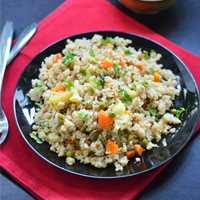
Ingredients
Instruction
- Heat a small pressure cooker with oil/ ghee.
- In medium flame, add cinnamon, fennel, bay leaf.
- Do not let fennel change its color.
- Add onion and give it a stir. Add ginger garlic paste.
- Fry for a minute in medium flame.
- Add the chopped veggies, mint leaves.
- Fry in medium flame for about 2 mins.
- You can add a little salt for the veggies.
- Add washed, drained millet to it and mix well. Let it dry. Flame should always in medium.
- Add water, salt and bring to boil. mix well and cook for a whistle in medium or low flame or in low flame possible for 12 mins.
Other facts
- In the Southern United States and Hawaii, it is considered to be a noxious weed.
- It may also have potential to be used as grass ties on hillside plots to prevent soil erosion, while also providing a famine food as a secondary purpose.
- It has been noted that it makes a good cover crop.
- Kodo millet is a nutritious grain and a good substitute to rice or wheat.
- It is also a good choice of animal fodder for cattle, goats, pigs, sheep, and poultry.
References:
https://www.itis.gov/servlet/SingleRpt/SingleRpt?search_topic=TSN&search_value=41040#null
http://www.hear.org/pier/species/paspalum_scrobiculatum.htm
https://npgsweb.ars-grin.gov/gringlobal/taxonomydetail.aspx?id=26917
https://www.cabi.org/isc/datasheet/38955
https://plants.usda.gov/core/profile?symbol=PASC6
http://www.theplantlist.org/tpl/record/kew-432275
https://en.wikipedia.org/wiki/Paspalum_scrobiculatum
Comments
comments


